Muscovite 40Ar/39Ar Age and H-O-S Isotopes of the Shimensi Tungsten Deposit (Northern Jiangxi Province, South China) and Their Metallogenic Implications
Abstract
:1. Introduction
2. Geological Background
2.1. Regional Geology
2.2. Deposit Geology
3. Sampling and Analytical Methods
3.1. Muscovite Ar-Ar Dating Method
3.2. Stable Isotope
4. Analytical Results
4.1. Muscovite Ar-Ar Age
4.2. Stable Isotopes
5. Discussion
5.1. Age of Mineralization
5.2. Source of Sulfur
5.3. Source of Ore-Forming Fluids
5.4. Boiling or Mixing?
5.5. Ore Deposition Processes
5.6. Tectonic Setting of the Shimensi Deposit
6. Conclusions
- (1)
- Muscovite 40Ar/39Ar age (145.70 ± 0.90 Ma) of the Shimensi deposit is consistent with the published zircon U-Pb age (143 to 148 Ma) of the ore-hosting granites, indicating a spatial-temporal link between them. The new age reported here confirms that the Shimensi tungsten deposit is part of a large Early Cretaceous (147–136 Ma) tungsten-polymetallic belt in South China.
- (2)
- A combination of δ34S, δD and δ18O evidence shows that the ore fluids are mixtures of magmatic and meteoric waters.
- (3)
- Quantitative modelling of isotopic compositions of quartz shows that magmatic-meteoric fluid mixing was likely the main metallogenic mechanism for the wolframite and scheelite precipitation at Shimensi.
Acknowledgments
Author Contributions
Conflicts of Interest
References
- Gong, X.D.; Yan, G.S.; Ye, T.Z.; Zhu, X.Y.; Li, Y.S.; Zhang, Z.H.; Jia, W.B.; Yao, X.F. A Study of ore-forming fluids in the Shimensi tungsten deposit, Dahutang tungsten polymetallic ore field, Jiangxi Province, China. Acta Geol. Sin. 2015, 89, 822–835. [Google Scholar]
- Jiang, S.Y.; Peng, N.J.; Huang, L.C.; Xu, Y.M.; Zhan, G.L.; Dan, X.H. Geological characteristic and ore genesis of the giant tungsten deposits from the Dahutang ore-concentrated district in northern Jiangxi Province. Acta Petrol. Sin. 2015, 31, 639–655. (In Chinese) [Google Scholar]
- Chen, G.; Shu, L.; Shu, L.; Zhang, C.; Ouyang, Y. Geological characteristics and mineralization setting of the Zhuxi tungsten (copper) polymetallic deposit in the Eastern Jiangnan Orogen. Sci. China Earth Sci. 2016, 59, 803–823. [Google Scholar] [CrossRef]
- Mao, Z.H.; Liu, J.J.; Mao, J.W.; Deng, J.; Zhang, F.; Meng, X.Y.; Xiong, B.K.; Xiang, X.K.; Luo, X.H. Geochronology and geochemistry of granitoids related to the giant Dahutang tungsten deposit, middle Yangtze River region, China: Implications for petrogenesis, geodynamic setting, and mineralization. Gondwana Res. 2015, 28, 816–836. [Google Scholar] [CrossRef]
- Zhang, Z.H.; Geng, L.; Jia, W.B.; Gong, X.D.; Du, Z.Z.; Zhang, M.C. Regional geological characteristics study of tungsten-polymetallic ore field in Dahutang tungsten polymetallic deposit in north of Jiangxi. China Min. Mag. 2014, 23, 133–148. (In Chinese) [Google Scholar]
- Cheng, Y.S.; Cao, X.M. Ore-forming Geological Conditions and Prospecting Potential in Dahutang W-Cu Polymetallic Ore District of North Jiangxi, China. Acta Geol. Sin. 2014, 88, 73–74. [Google Scholar] [CrossRef]
- Feng, C.Y.; Zhang, D.Q.; Xiang, X.; Li, D.X.; Qu, H.; Liu, J.; Xiao, Y. Re-Os isotopic dating of molybdenite from the Dahutang tungsten deposit in northwestern Jiangxi Province and its geological implication. Acta Petrol. Sin. 2012, 28, 3858–3868. (In Chinese) [Google Scholar]
- Mao, Z.H.; Cheng, Y.B.; Liu, J.J.; Yuan, S.D.; Wu, S.H.; Xiang, X.K.; Luo, X.H. Geology and molybdenite Re–Os age of the Dahutang granite-related veinlets-disseminated tungsten ore field in the Jiangxin Province, China. Ore Geol. Rev. 2013, 53, 422–433. [Google Scholar] [CrossRef]
- Xiang, X.K.; Wang, P.; Sun, D.M.; Zhong, B. Isotopic geochemical characteristics of the Shimensi tungsten-polymetallic deposit in northern Jiangxi province. Acta Geosci. Sin. 2013, 34, 263–271. (In Chinese) [Google Scholar]
- Xiang, X.K.; Wang, P.; Zhan, G.; Sun, D.M.; Zhong, B.; Qian, Z.; Tan, R. Geological characteristics of Shimensi tungsten polymetallic deposit in northern Jiangxi Province. Miner. Depos. 2013, 32, 1171–1187. (In Chinese) [Google Scholar]
- Xiang, X.K.; Yin, Q.; Feng, C.Y.; Wang, H.; Liu, N.; Yu, Z. Elements and fluids migration regularity of granodiorite alteration zones in the Shimensi tungsten polymetallic deposit in nouthern Jiangxi and their constrain on mineralization. Acta Geol. Sin. 2015, 89, 1273–1287. (In Chinese) [Google Scholar]
- Huang, L.C.; Jiang, S.Y. Highly fractionated S-type granites from the giant Dahutang tungsten deposit in Jiangnan Orogen, Southeast China: Geochronology, petrogenesis and their relationship with W-mineralization. Lithos 2014, 202–203, 207–226. [Google Scholar] [CrossRef]
- Ruan, K.; Pan, J.Y.; Wu, J.Y.; Xiang, X.K.; Liu, W.Q.; Li, Z.S. Geochemical characteristics and ore genesis of the Shimensi cryptoexplosive breccia type tungsten deposit in Dahutang, Jiangxi Province. Bull. Mineral. Petrol. Geochem. 2015, 34, 633–641. (In Chinese) [Google Scholar]
- Wang, P. Study on the Geological Characteristics, Ore-forming Fluid and Geochronology of the Shimensi Polymetallic Tungsten Deposit, Northern Jiangxi Province. Master’s Thesis, Sinosteel Tianjin Geological Academy, Tianjing, China, 2013. (In Chinese). [Google Scholar]
- Xiang, X.K.; Wang, P.; Sun, D.M.; Zhong, B. Re-Os isotopic age of molybdeinte from the Shimensi tungsten polymetallic deposit in northern Jiangxi Province and its geological implications. Geol. Bull. China. 2013, 32, 1824–1831. (In Chinese) [Google Scholar]
- Hu, R.Z.; Wei, W.F.; Bi, X.W.; Peng, J.T.; Qi, Y.Q.; Wu, L.Y.; Chen, Y.W. Molybdenite Re–Os and muscovite 40Ar/39Ar dating of the Xihuashan tungsten deposit, central Nanling district, South China. Lithos 2012, 150, 111–118. [Google Scholar] [CrossRef]
- Shu, L.S. An analysis of principal features of tectonic evolution in South China Block. Geol. Bull. China 2012, 31, 1035–1053. (In Chinese) [Google Scholar]
- Xiang, X.K.; Liu, X.M.; Zhan, G.N. Discovery of Shimensi superlarge tungsten deposit and its prospecting significance in Dahutang area, Jiangxi Province. Resour. Surv. Environ. 2012, 33, 141–151. (In Chinese) [Google Scholar]
- Sun, K.; Chen, B. Trace elements and Sr-Nd isotopes of scheelite: Implications for the W-Cu-Mo polymetallic mineralization of the Shimensi deposit, South China. Am. Mineral. 2017, 102, 1114–1128. [Google Scholar]
- Wang, F.; Zhou, X.H.; Zhang, L.C.; Ying, J.F.; Zhang, Y.T.; Wu, F.Y.; Zhu, R.X. Late Mesozoic volcanism in the Great Xing’an Range (NE China): Timing and implications for the dynamic setting of NE Asia. Earth Planet. Sci. Lett. 2006, 251, 179–198. [Google Scholar] [CrossRef]
- Koppers, A.A.P. ArArCALC—Software for 40Ar/39Ar age calculations. Compu. Geosci. 2002, 28, 605–619. [Google Scholar] [CrossRef]
- Clayton, R.N.; Mayeda, T.K. The use of bromine pentafluoride in the extraction of oxygen from oxides and silicates for isotopic analysis. Geochim. Cosmochim. Acta 1963, 27, 43–52. [Google Scholar] [CrossRef]
- Friedman, I. Deuterium content of natural waters and other substances. Geochim. Cosmochim. Acta 1953, 4, 89–103. [Google Scholar] [CrossRef]
- Grassineau, N.V.; Mattey, D.P.; Lowry, D. Sulfur Isotope Analysis of Sulfide and Sulfate Minerals by Continuous Flow-Isotope Ratio Mass Spectrometry. Anal. Chem. 2001, 73, 220–225. [Google Scholar] [CrossRef] [PubMed]
- Lee, J.Y.; Marti, K.; Severinghaus, J.P.; Kawamura, K.; Yoo, H.S.; Lee, J.B.; Kim, J.S. A redetermination of the isotopic abundances of atmospheric Ar. Geochim. Cosmochim. Acta 2006, 70, 4507–4512. [Google Scholar] [CrossRef]
- Clayton, R.N.; O’Neil, J.; Mayeda, T. Oxygen isotope exchange between quartz and water. J. Geophys. Res. 1972, 77, 3057–3067. [Google Scholar] [CrossRef]
- Rusk, B.G.; Reed, M.H.; Dilles, J.H. Fluid inclusion evidence for magmatic-hydrothermal fluid evolution in the porphyry copper-molybdenum deposit at Butte, Montana. Econ. Geol. 2008, 103, 307–334. [Google Scholar] [CrossRef]
- Liu, L.; Yan, B.; Wei, W.F.; Yan, H.; Li, J.; Deng, X.W. Characteristics and significance of the fluid inclusions in quartz veins type ore bodies from Shimensi tungsten deposit, northern Jiangxi. J. Miner. Petrol. 2016, 36, 44–52. (In Chinese) [Google Scholar]
- Ye, Z.Y.; Zhang, Z.Y.; Pan, X.F.; Peng, H.M. A study of the relationship of W-Cu-Mo mineralization features of the Shimensi ore district in northern Dahutang, Jiangxi Province. Acta Petrol. Miner. 2016, 35, 457–468. (In Chinese) [Google Scholar]
- Stein, H.J.; Sundblad, K.; Markey, R.J.; Morgan, J.W.; Motuza, G. Re-Os ages for Archean molybdenite and pyrite, Kuittila-Kivisuo, Finland and Proterozoic molybdenite, Kabeliai, Lithuania: Testing the chronometer in a metamorphic and metasomatic setting. Miner. Depos. 1998, 33, 329–345. [Google Scholar] [CrossRef]
- Stein, H.J.; Markey, R.J.; Morgan, J.W.; Hannah, J.L.; Scherstén, A. The remarkable Re-Os chronometer in molybdenite: How and why it works. Terra Nova 2001, 13, 479–486. [Google Scholar] [CrossRef]
- Stein, H.; Scherstén, A.; Hannah, J.; Markey, R. Subgrain-scale decoupling of Re and 187Os and assessment of laser ablation ICP-MS spot dating in molybdenite. Geochim. Cosmochim. Acta 2003, 67, 3673–3686. [Google Scholar] [CrossRef]
- Selby, D.; Creaser, R.A. Macroscale NTIMS and microscale LA-MC-ICP-MS Re-Os isotopic analysis of molybdenite: Testing spatial restrictions for reliable Re-Os age determinations, and implications for the decoupling of Re and Os within molybdenite. Geochim. Cosmochim. Acta 2004, 68, 3897–3908. [Google Scholar] [CrossRef]
- Li, C.; Qu, W.J.; Du, A.D. Decoupling of Re and Os and migration model of 187Os in coarse-grained molybdenite. Miner. Depos. 2009, 28, 707–712. (In Chinese) [Google Scholar]
- Peng, J.T.; Zhou, M.F.; Hu, R.Z.; Shen, N.P.; Yuan, S.D.; Bi, X.W.; Du, A.D.; Qu, W.J. Precise molybdenite Re-Os and mica Ar-Ar dating of the Mesozoic Yaogangxian tungsten deposit, central Nanling district, South China. Miner. Depos. 2006, 41, 661–669. [Google Scholar] [CrossRef]
- Hames, W.E.; Bowring, S.A. An empirical evaluation of the argon diffusion geometry in muscovite. Earth Planet. Sci. Lett. 1994, 124, 161–169. [Google Scholar] [CrossRef]
- Snee, L.W.; Sutter, J.F.; Kelly, W.C. Thermochronology of economic mineral deposits; dating the stages of mineralization at Panasqueira, Portugal, by high-precision 40Ar/39Ar age spectrum techniques on muscovite. Econ. Geol. 1988, 83, 335–354. [Google Scholar] [CrossRef]
- Harrison, T.M.; Célérier, J.; Aikman, A.B.; Hermann, J.; Heizler, M.T. Diffusion of 40Ar in muscovite. Geochim. Cosmochim. Acta 2009, 73, 1039–1051. [Google Scholar] [CrossRef]
- Ohmoto, H.; Goldhaber, M.B. Sulfur and carbon isotopes. In Geochemistry of Hydrothermal Ore Deposits, 3rd ed.; Barnes, H.L., Ed.; John Wiley Sons: New York, NY, USA, 1997; pp. 517–611. [Google Scholar]
- Wei, W.F.; Hu, R.Z.; Bi, X.W.; Peng, J.T.; Su, W.C.; Song, S.Q.; Shi, S.H. Infrared microthermometric and stable isotopic study of fluid inclusions in wolframite at the Xihuashan tungsten deposit, Jiangxi province, China. Miner. Depos. 2012, 47, 589–605. [Google Scholar] [CrossRef]
- Cai, Y.; Ma, D.S.; Lu, J.J.; Huang, H.; Zhang, R.Q.; Qu, W.J. Re-Os geochronology and S isotope geochemistry of Dengfuxian tungsten deposit, Hunan Province, China. Acta Petrol. Sin. 2012, 28, 3798–3808. (In Chinese) [Google Scholar]
- Song, S.Q.; Hu, R.Z.; Bi, X.W.; Wei, W.F.; Shi, S.H. Hydrogen, oxygen and sulfur isotope geochemical characteristics of Taoxikeng tungsten deposit in Chongyi County, Southern Jiangxi Province. Miner. Depos. 2011, 30, 1–10. (In Chinese) [Google Scholar]
- Kelly, W.C.; Rye, R.O. Geologic, fluid inclusion, and stable isotope studies of the tin-tungsten deposits of Panasqueira, Portugal. Econ. Geol. 1979, 74, 1721–1822. [Google Scholar] [CrossRef]
- Rye, R.O. The evolution of magmatic fluids in the epithermal environment: The stable isotope perspective. Econ. Geol. 1993, 88, 733–752. [Google Scholar] [CrossRef]
- Audetat, A.; Pettke, T.; Heinrich, C.A.; Bodnar, R.J. Special Paper: The Composition of Magmatic-Hydrothermal Fluids in Barren and Mineralized Intrusions. Econ. Geol. 2008, 103, 877–908. [Google Scholar] [CrossRef]
- Taylor, H. Oxygen and hydrogen isotope relationships in hydrothermal mineral deposits. In Geochemistry of Hydrothermal ore Deposits, 3rd ed.; Barnes, H.L., Ed.; John Wiley Sons: New York, NY, USA, 1997; pp. 229–302. [Google Scholar]
- Wagner, T.; Mlynarczyk, M.S.J.; Williams-Jones, A.E.; Boyce, A.J. Stable isotope constraints on ore formation at the San Rafael tin-copper deposit, Southeast Peru. Econ. Geol. 2009, 104, 223–248. [Google Scholar] [CrossRef]
- Wagner, T.; Williams-Jones, A.E.; Boyce, A.J. Stable isotope-based modeling of the origin and genesis of an unusual Au-Ag-Sn-W epithermal system at Cirotan, Indonesia. Chem. Geol. 2005, 219, 237–260. [Google Scholar] [CrossRef]
- Matsuhisa, Y.; Goldsmith, J.R.; Clayton, R.N. Oxygen isotopic fractionation in the system quartz-albite-anorthite-water. Geochim. Cosmochim. Acta 1979, 43, 1131–1140. [Google Scholar] [CrossRef]
- Zhang, L.G. Retrogentic and Minerogenetic Theories and Prospecting: Stable Isotopic Geochemistry of Main Type ore Deposits and Granitoids of China, 1st ed.; Press of Beijing University of Technology: Beijing, China, 1989; pp. 49–65. (In Chinese) [Google Scholar]
- Wood, S.A.; Samson, I.M. The Hydrothermal geochemistry of tungsten in granitoid environments: I. Relative solubilities of ferberite and scheelite as a function of T, P, pH, and mNaCl. Econ. Geol. 2000, 95, 143–182. [Google Scholar] [CrossRef]
- Graupner, T.; Kempe, U.; Dombon, E.; Pätzold, O.; Leeder, O.; Spooner, E.T.C. Fluid regime and ore formation in the tungsten(-yttrium) deposits of Kyzyltau (Mongolian Altai): Evidence for fluid variability in tungsten-tin ore systems. Chem. Geol. 1999, 154, 21–58. [Google Scholar] [CrossRef]
- Beuchat, S.; Moritz, R.; Pettke, T. Fluid evolution in the W-Cu-Zn-Pb San Cristobal vein, Peru: Fluid inclusion and stable isotope evidence. Chem. Geol. 2004, 210, 201–224. [Google Scholar] [CrossRef]
- Moura, A.; Dória, A.; Neiva, A.M.R.; Leal Gomes, C.; Creaser, R.A. Metallogenesis at the Carris W-Mo-Sn deposit (Gerês, Portugal): Constraints from fluid inclusions, mineral geochemistry, Re-Os and He-Ar isotopes. Ore Geol. Rev. 2014, 56, 73–93. [Google Scholar] [CrossRef]
- Xi, B.B.; Zhang, D.H.; Zhou, L.M.; Zhang, W.H.; Wang, C. Characteristics of ore-forming fluid evolution in Dajishan tungsten deposit, Quannan county, Jiangxi. Acta Geol. Sin. 2008, 82, 956–966. (In Chinese) [Google Scholar]
- Gong, Q.J.; Yu, C.W.; Zhang, R.H. Physical chemistry study on the ore-forming process of Shizhuyuan tungsten-polymetallic deposit. Earth Sci. Front. 2004, 11, 617–625. (In Chinese) [Google Scholar]
- Polya, D.A. Chemistry of the main-stage ore-forming fluids of the Panasqueira W-Cu(Ag)-Sn deposit, Portugal: Implications for models of ore genesis. Econ. Geol. 1989, 84, 1134–1152. [Google Scholar] [CrossRef]
- Ding, W.K. Research of Alteration Zone in Shimensi Tungsten Polymetallic Deposit. Master’s Thesis, East China University of Technology, Fuzhou, China, 2016. (In Chinese). [Google Scholar]
- Koděra, P.; Lexa, J.; Rankin, A.H.; Fallick, A.E. Epithermal gold veins in a caldera setting: Banská Hodruša, Slovakia. Miner. Depos. 2005, 39, 921–943. [Google Scholar] [CrossRef]
- Yoo, B.; Lee, H.; White, N. Mineralogical, fluid inclusion, and stable isotope constraints on mechanisms of ore deposition at the Samgwang mine (Republic of Korea)—A mesothermal, vein-hosted gold-silver deposit. Miner. Depos. 2010, 45, 161–187. [Google Scholar] [CrossRef]
- Hulsbosch, N.; Boiron, M.C.; Dewaele, S.; Muchez, P. Fluid fractionation of tungsten during granite–pegmatite differentiation and the metal source of peribatholitic W quartz veins. Evidence from the Karagwe-Ankole Belt (Rwanda). Geochim. Cosmochim. Acta 2016, 175, 299–318. [Google Scholar] [CrossRef]
- Shi, H.Z.; Lin, F.C.; Zhang, L.K. Spatio-temporal distribution and current state of the research of the tungsten deposits: An overview. Sediment. Geol. Tethyan Geol. 2009, 29, 90–95. (In Chinese) [Google Scholar]
- Werner, A.B.T.; Sinclair, W.D.; Amey, E.B. International Strategic Mineral Issues Summary Report—Tungsten; U.S. Geological Survey Circular 930-O; United States Government Printing Office: Washington, DC, USA, 1998; pp. 1–71.
- Burnard, P.G.; Polya, D.A. Importance of mantle derived fluids during granite associated hydrothermal circulation: He and Ar isotopes of ore minerals from Panasqueira. Geochim. Cosmochim. Acta 2004, 68, 1607–1615. [Google Scholar] [CrossRef]
- Sato, K. Sedimentary Crust and Metallogeny of Granitoid Affinity: Implications from the Geotectonic Histories of the Circum-Japan Sea Region, Central Andes and Southeastern Australia. Resour. Geol. 2012, 62, 329–351. [Google Scholar] [CrossRef]
- Hart, C.J.R.; Mair, J.L.; Goldfarb, R.J.; Groves, D.I. Source and redox controls on metallogenic variations in intrusion-related ore systems, Tombstone-Tungsten Belt, Yukon Territory, Canada. Trans. Royal Soc. Edinb. Earth Sci. 2004, 95, 339–356. [Google Scholar] [CrossRef]
- Romer, R.L.; Kroner, U. Phanerozoic tin and tungsten mineralization—Tectonic controls on the distribution of enriched protoliths and heat sources for crustal melting. Gondwana Res. 2016, 31, 60–95. [Google Scholar] [CrossRef]
- Mao, J.W.; Cheng, Y.B.; Chen, M.H.; Pirajno, F. Major types and time-space distribution of Mesozoic ore deposits in South China and their geodynamic settings. Miner. Depos. 2013, 48, 267–294. [Google Scholar]
- Liu, P.; Mao, J.W.; Cheng, Y.B.; Yao, W.; Wang, X.Y.; Hao, D. An Early Cretaceous W-Sn deposit and its implications in southeast coastal metallogenic belt: Constraints from U-Pb, Re-Os, Ar-Ar geochronology at the Feie’shan W-Sn deposit, SE China. Ore Geol. Rev. 2017, 81, 112–122. [Google Scholar] [CrossRef]
- Pan, X.F.; Hou, Z.Q.; Li, Y.; Chen, G.H.; Zhao, M.; Zhang, T.F.; Zhang, C.; Wei, J.; Kang, C. Dating the giant Zhuxi W-Cu deposit (Taqian-Fuchun Ore Belt) in South China using molybdenite Re-Os and muscovite Ar-Ar system. Ore Geol. Rev. 2017, 86, 719–733. [Google Scholar] [CrossRef]
- Mao, J.W.; Xiong, B.K.; Liu, J.; Pirajno, F.; Cheng, Y.B.; Ye, H.S.; Song, S.W.; Dai, P. Molybdenite Re/Os dating, zircon U-Pb age and geochemistry of granitoids in the Yangchuling porphyry W-Mo deposit (Jiangnan tungsten ore belt), China: Implications for petrogenesis, mineralization and geodynamic setting. Lithos 2017, 286–287, 35–52. [Google Scholar] [CrossRef]
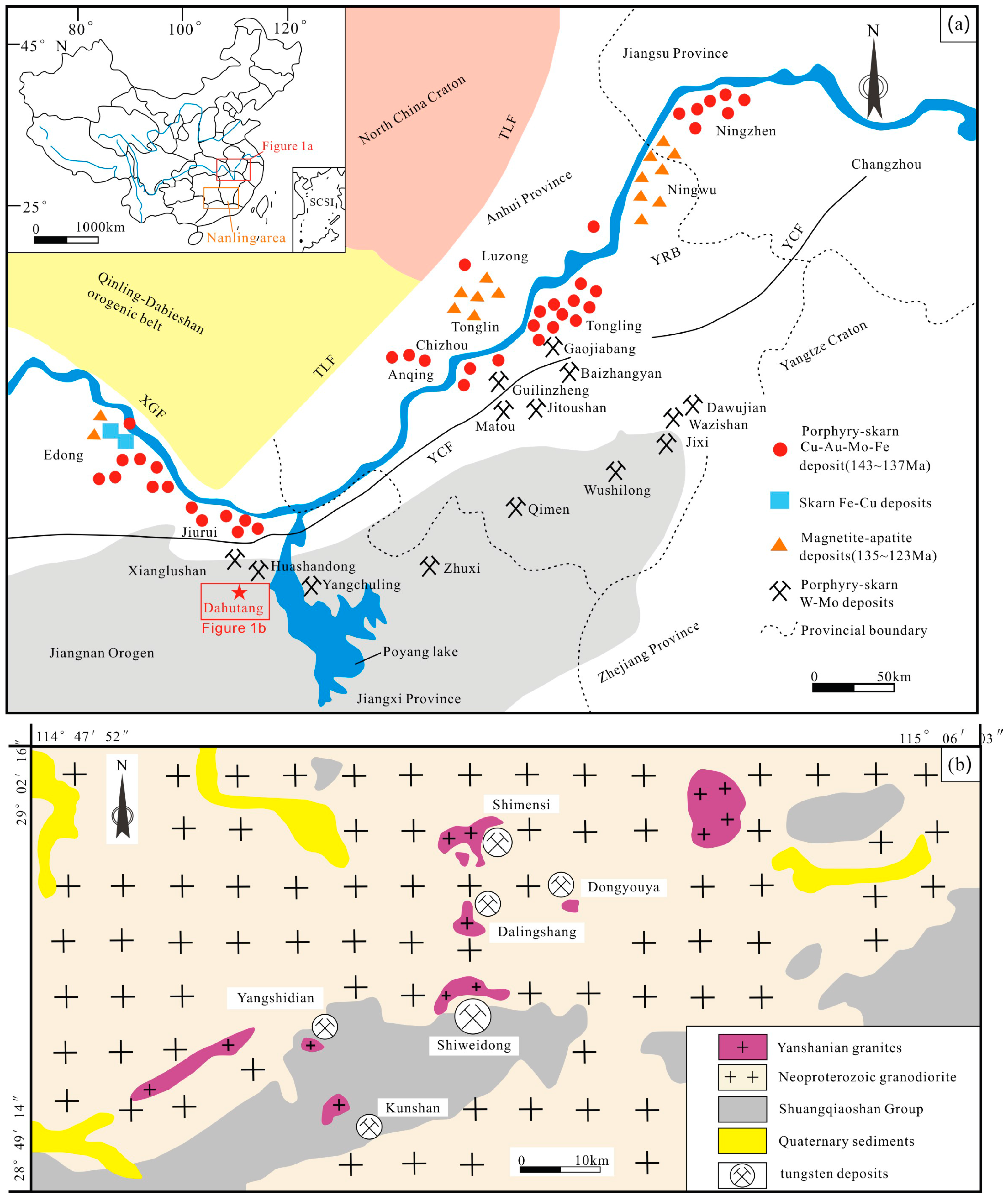
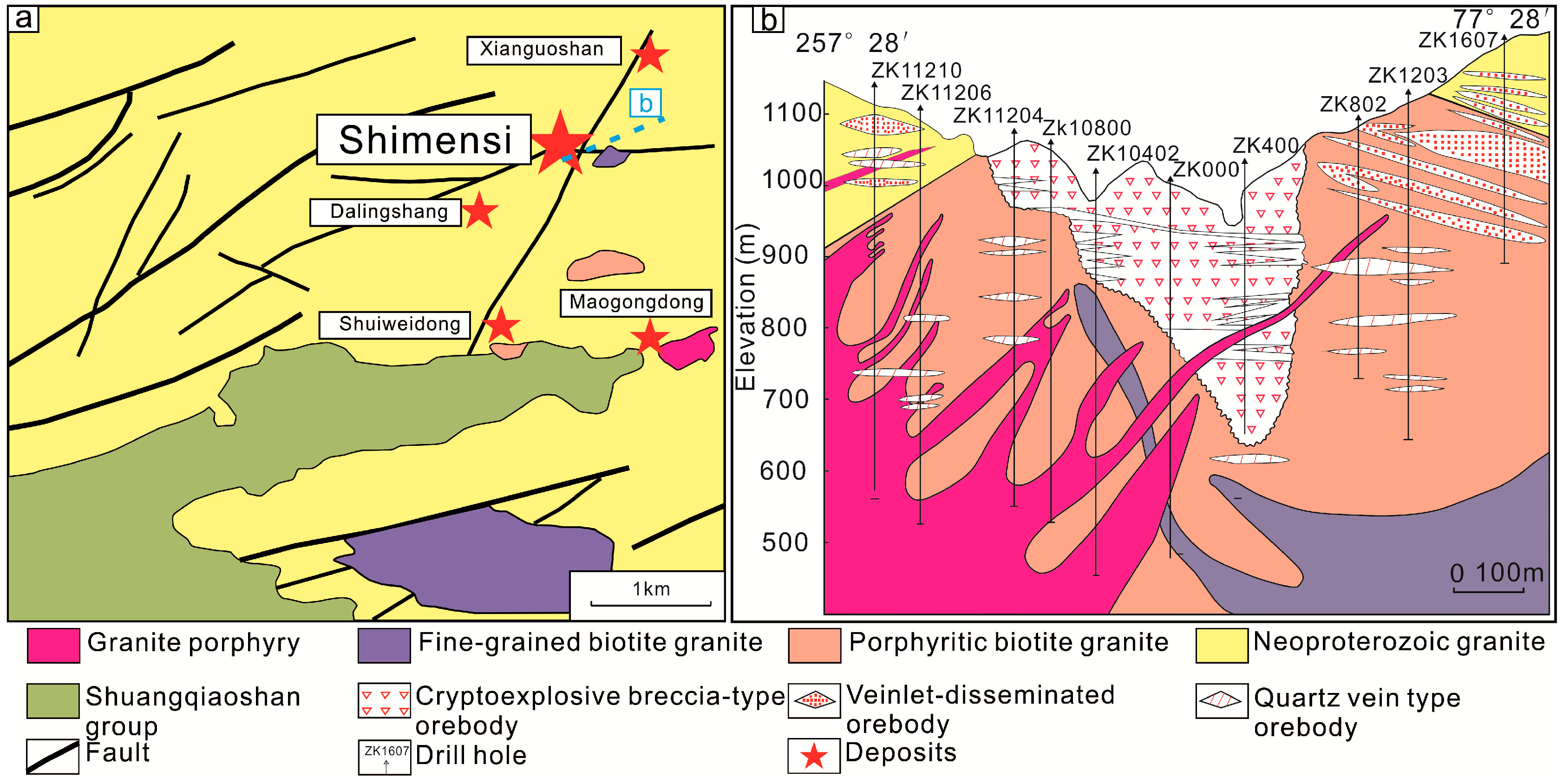
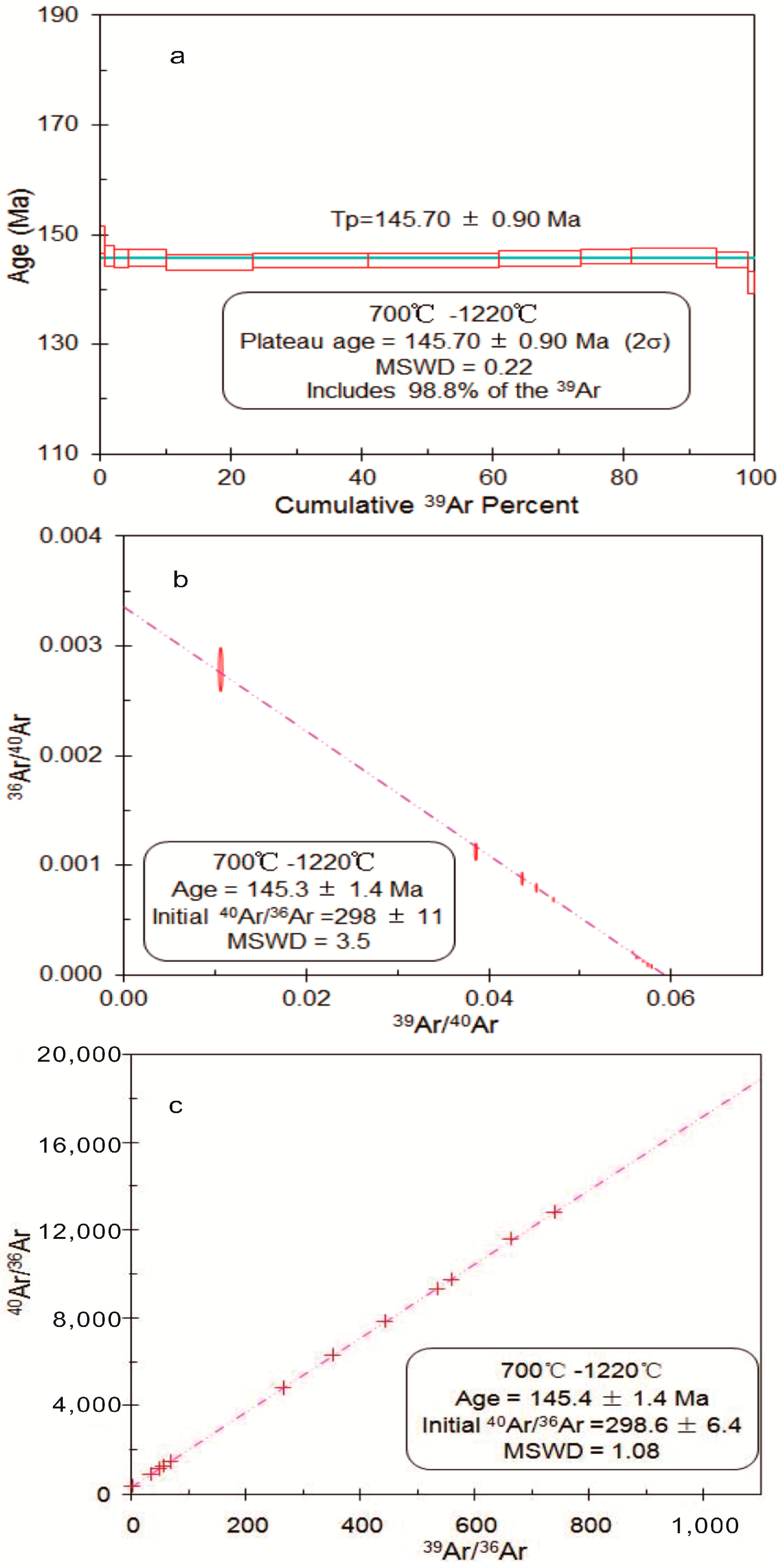
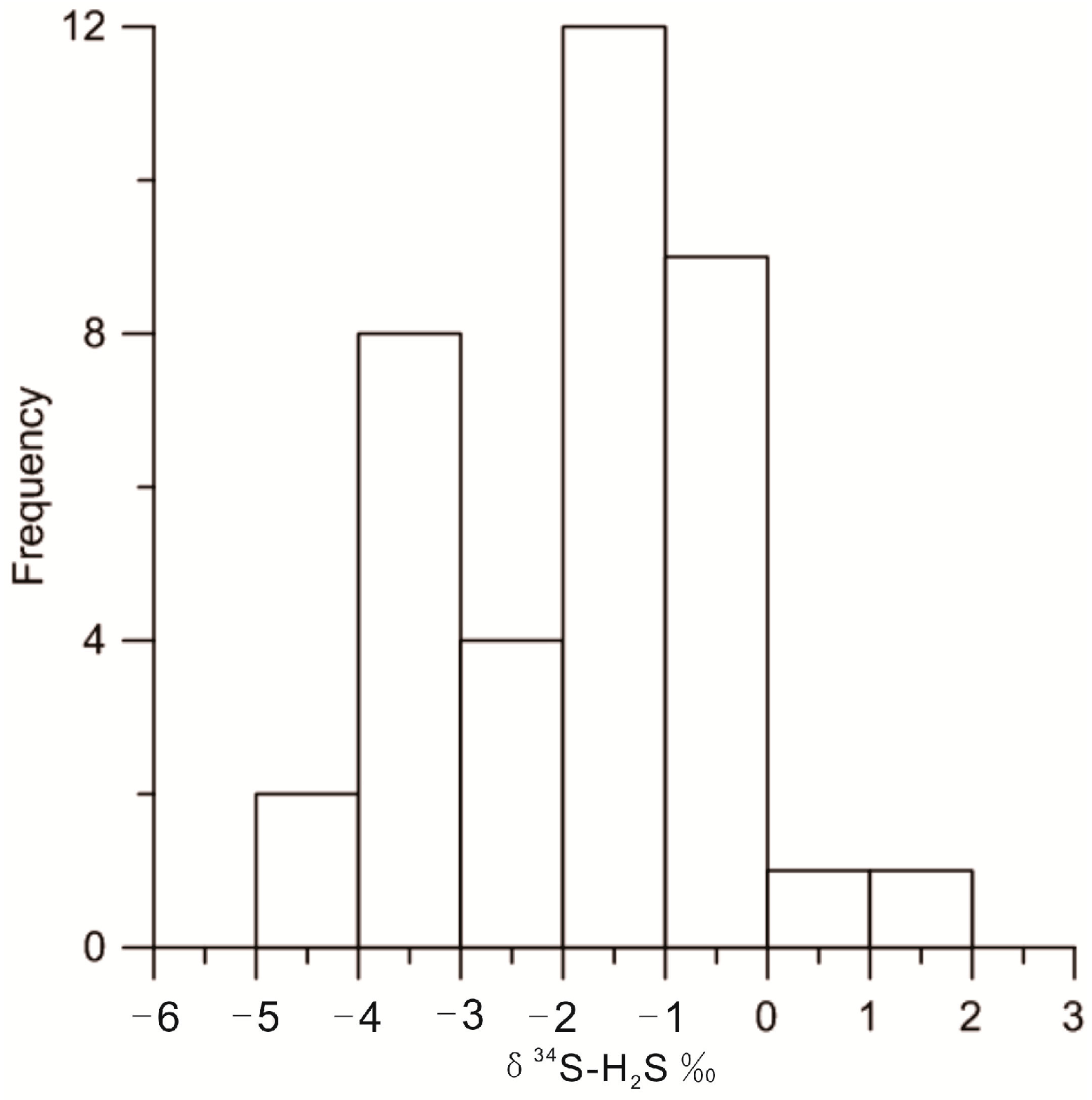
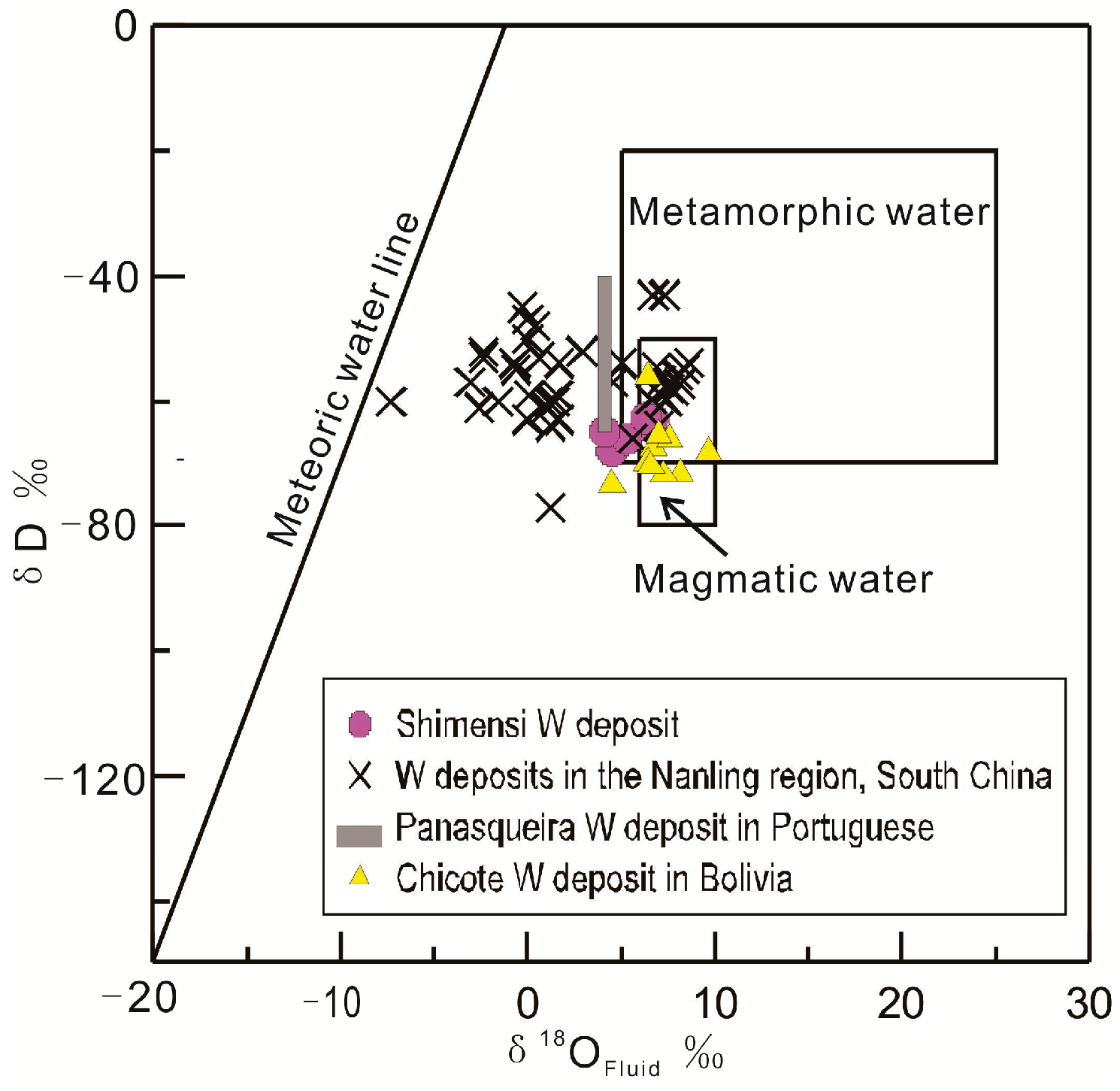
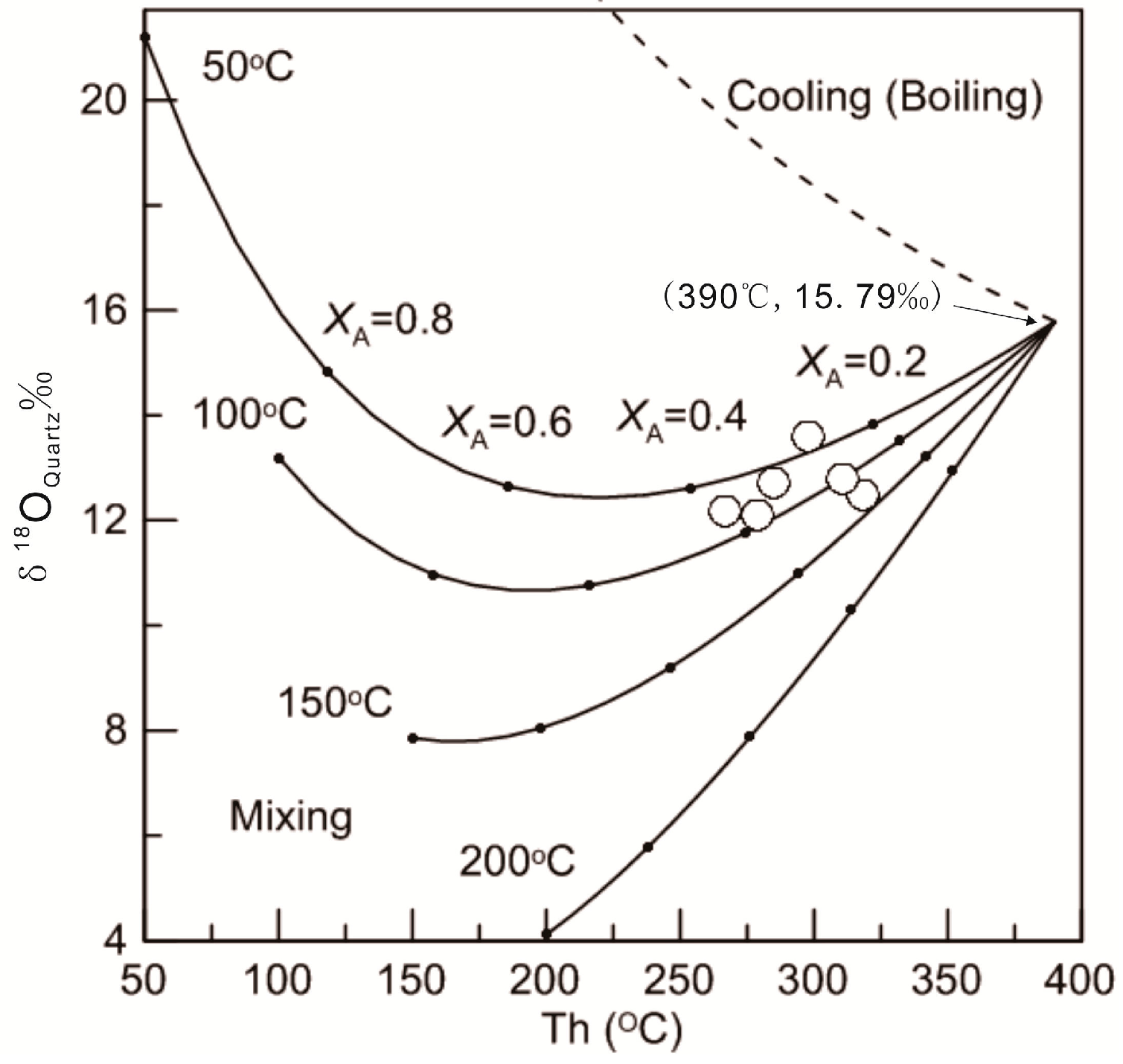
| T (°C) | (40Ar/39Ar)m | (36Ar/39Ar)m | (37Ar0/39Ar)m | (38Ar/39Ar)m | 40Ar (%) | F | 39Ar (×10−14 mol) | 39Ar (Cum.) (%) | Age (Ma) | ±1σ (Ma) |
|---|---|---|---|---|---|---|---|---|---|---|
| 700 | 94.2546 | 0.2635 | 3.4274 | 0.0727 | 17.64 | 16.6767 | 0.02 | 0.08 | 144.0 | 20.0 |
| 770 | 25.9362 | 0.0291 | 0.0093 | 0.0162 | 66.79 | 17.3232 | 0.23 | 0.84 | 149.0 | 2.5 |
| 820 | 22.9143 | 0.0201 | 0.0576 | 0.0167 | 74.05 | 16.9697 | 0.38 | 2.15 | 146.1 | 1.9 |
| 860 | 22.1199 | 0.0176 | 0.1290 | 0.0166 | 76.49 | 16.9215 | 0.66 | 4.41 | 145.7 | 1.6 |
| 900 | 21.2446 | 0.0146 | 0.0235 | 0.0154 | 79.69 | 16.9292 | 1.70 | 10.20 | 145.7 | 1.5 |
| 940 | 17.9495 | 0.0038 | 0.0252 | 0.0134 | 93.81 | 16.8385 | 3.85 | 23.31 | 145.0 | 1.4 |
| 980 | 17.4116 | 0.0018 | 0.0044 | 0.0130 | 96.94 | 16.8793 | 5.19 | 41.00 | 145.3 | 1.4 |
| 1020 | 17.4304 | 0.0019 | 0.0062 | 0.0130 | 96.80 | 16.8734 | 5.80 | 60.78 | 145.3 | 1.4 |
| 1060 | 17.5796 | 0.0023 | 0.0164 | 0.0131 | 96.19 | 16.9102 | 3.73 | 73.51 | 145.6 | 1.4 |
| 1100 | 17.8003 | 0.0028 | 0.0402 | 0.0133 | 95.28 | 16.9599 | 2.20 | 81.01 | 146.0 | 1.4 |
| 1160 | 17.4189 | 0.0015 | 0.0030 | 0.0129 | 97.42 | 16.9693 | 3.86 | 94.17 | 146.1 | 1.4 |
| 1220 | 17.2956 | 0.0014 | 0.0438 | 0.0131 | 97.66 | 16.8919 | 1.37 | 98.84 | 145.4 | 1.4 |
| 1400 | 18.8968 | 0.0086 | 0.3145 | 0.0154 | 86.71 | 16.3887 | 0.34 | 100.00 | 141.3 | 2.1 |
| Sample No. | Mineralization Style | Mineral | δD (‰) | δ18OQuartz (‰) | (‰) | Th (°C) |
|---|---|---|---|---|---|---|
| SMS-10 | Quartz vein | Quartz | −68.0 | 12.1 | 4.5 | 262–279 |
| SMS-9 | Quartz vein | Quartz | −63.9 | 12.5 | 6.3 | 302–318 |
| SMS-17 | Quartz vein | Quartz | −66.1 | 12.7 | 5.3 | 274–285 |
| SMS-5 | Quartz vein | Quartz | −63.0 | 13.6 | 6.7 | 281–298 |
| SMS-16 | Cryptoexplosion breccia | Quartz | −64.9 | 12.2 | 4.1 | 256–267 |
| SMS-24 | Cryptoexplosion breccia | Quartz | −62.7 | 12.8 | 6.3 | 295–311 |
| Sample No | Mineralization Style | Mineral | δ34S Sulfide ‰ | ‰ | Data Sources |
|---|---|---|---|---|---|
| SMS-16 | Cryptoexplosion breccia | Chalcopyrite | −1.4 | −1.2 | This study |
| SMS-24 | Cryptoexplosion breccia | Chalcopyrite | −1.7 | −1.6 | |
| SMS-16 | Cryptoexplosion breccia | Molybdenite | −2.5 | −4.0 | |
| SMS-9 | Quartz vein type | Chalcopyrite | −1.4 | −1.3 | |
| SMS-10 | Quartz vein type | Chalcopyrite | −0.8 | −0.6 | |
| SMS-10 | Quartz vein type | Molybdenite | −3.0 | −4.5 | |
| SMS-17 | Quartz vein type | Molybdenite | −1.9 | −3.3 | |
| SMS-5 | Quartz vein type | Bornite | −1.6 | −1.8 | |
| SMS-17 | Quartz vein type | Chalcopyrite | −1.2 | −1.0 | |
| SMS-7 * | Quartz vein type | Pyrite | −2.2 | −3.4 | |
| SMS-40 * | Quartz vein type | Molybdenite | −2.0 | −3.9 | |
| SMS-22 * | Quartz vein type | Molybdenite | −1.4 | −2.8 | |
| Y08 | Cryptoexplosion breccia | Chalcopyrite | −0.5 | −0.4 | Ruan et al. [13] |
| Y17 | Cryptoexplosion breccia | Chalcopyrite | −1.0 | −0.9 | |
| Y40-2 | Cryptoexplosion breccia | Chalcopyrite | −1.4 | −1.3 | |
| Y40-2 | Cryptoexplosion breccia | Chalcopyrite | −0.6 | −0.5 | |
| Y43 | Cryptoexplosion breccia | Chalcopyrite | −0.2 | −0.1 | |
| Y61-2 | Cryptoexplosion breccia | Chalcopyrite | −1.3 | −1.2 | |
| Y62-2 | Cryptoexplosion breccia | Chalcopyrite | −0.5 | −0.4 | |
| Y63 | Cryptoexplosion breccia | Chalcopyrite | −0.1 | 0.0 | |
| Y66 | Cryptoexplosion breccia | Chalcopyrite | −1.2 | −1.1 | |
| Y67-2 | Cryptoexplosion breccia | Chalcopyrite | −1.0 | −0.9 | |
| Y68 | Cryptoexplosion breccia | Chalcopyrite | −0.9 | −0.8 | |
| Y76-2 | Cryptoexplosion breccia | Chalcopyrite | 1.1 | 1.2 | |
| Y12 | Cryptoexplosion breccia | Molybdenite | −0.8 | −1.8 | |
| Y40-1 | Cryptoexplosion breccia | Molybdenite | −0.4 | −1.4 | |
| Y62-1 | Cryptoexplosion breccia | Molybdenite | 0.2 | −0.8 | |
| SM156-1 | Cryptoexplosion breccia | Chalcopyrite | −1.7 | −1.6 | Wang [14] |
| SM156-2 | Cryptoexplosion breccia | Chalcopyrite | −1.6 | −1.5 | |
| Mo-SP1 | Cryptoexplosion breccia | Molybdenite | −2.5 | −3.7 | |
| Mo-SP2 | Cryptoexplosion breccia | Molybdenite | −1.0 | −2.2 | |
| Mo-SP4 | Cryptoexplosion breccia | Molybdenite | −2.0 | −3.2 | |
| Mo-SP6 | Cryptoexplosion breccia | Molybdenite | −1.8 | −3.0 | |
| Mo-SP8 | Cryptoexplosion breccia | Molybdenite | −1.9 | −3.0 | |
| Mo-SP3 | Quartz vein type | Molybdenite | −1.6 | −2.8 | |
| Mo-SP5 | Quartz vein type | Molybdenite | −1.9 | −3.1 | |
| Mo-SP7 | Quartz vein type | Molybdenite | −2.0 | −3.2 |
© 2017 by the authors. Licensee MDPI, Basel, Switzerland. This article is an open access article distributed under the terms and conditions of the Creative Commons Attribution (CC BY) license (http://creativecommons.org/licenses/by/4.0/).
Share and Cite
Wei, W.-F.; Yan, B.; Shen, N.-P.; Liu, L.; Zhang, Y.; Xiang, X.-K. Muscovite 40Ar/39Ar Age and H-O-S Isotopes of the Shimensi Tungsten Deposit (Northern Jiangxi Province, South China) and Their Metallogenic Implications. Minerals 2017, 7, 162. https://doi.org/10.3390/min7090162
Wei W-F, Yan B, Shen N-P, Liu L, Zhang Y, Xiang X-K. Muscovite 40Ar/39Ar Age and H-O-S Isotopes of the Shimensi Tungsten Deposit (Northern Jiangxi Province, South China) and Their Metallogenic Implications. Minerals. 2017; 7(9):162. https://doi.org/10.3390/min7090162
Chicago/Turabian StyleWei, Wen-Feng, Bing Yan, Neng-Ping Shen, Lei Liu, Yong Zhang, and Xin-Kui Xiang. 2017. "Muscovite 40Ar/39Ar Age and H-O-S Isotopes of the Shimensi Tungsten Deposit (Northern Jiangxi Province, South China) and Their Metallogenic Implications" Minerals 7, no. 9: 162. https://doi.org/10.3390/min7090162





